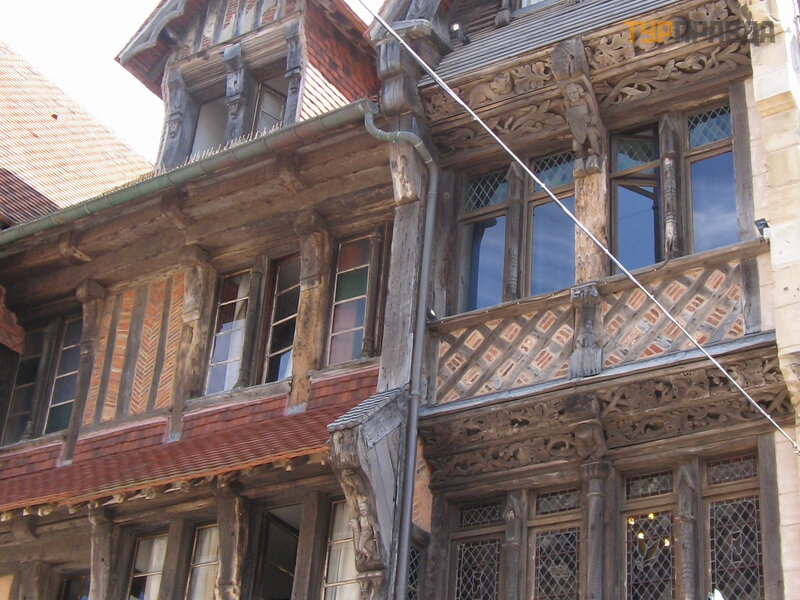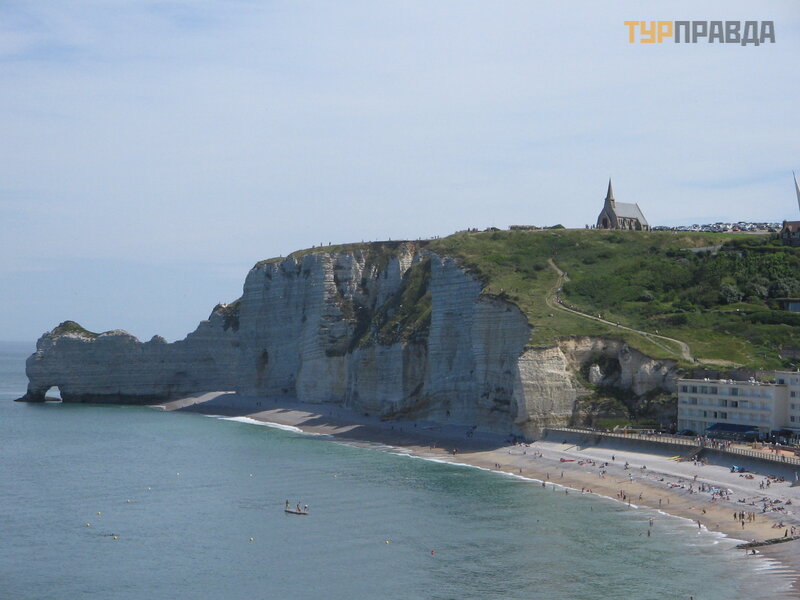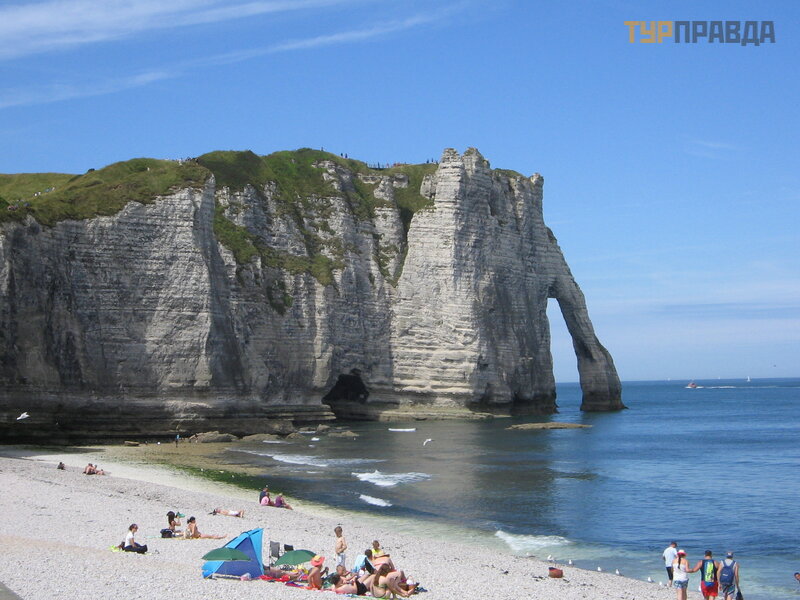In the footsteps of Monet - part 4
Continuation. Start here:
Etretat is one of those places on the route that I definitely wanted to visit. Seeing the amazing pictures of these arches over the sea, I understood that I wanted to see it all with my own eyes. And this turned out to be the case when what was taken away in the photo, even of very high quality, turned out to be more faded than what was seen live. It happens that professional photos show the place much better than it is in reality. But more often it turns out that reality is richer than any photo or video. Etretat (like Fecamp, which I wrote about earlier) are small places: in Fecamp there are about 20 thousand inhabitants, in Etretat - less than 2 thousand. But you can spend the whole day in them.
If you love nature, they are worth wandering along the coast (there are hiking trails everywhere) over the sheer shore, looking down (going down is not recommended, there are noticeable tides in the English Channel). I don't know if it is possible to get the same pleasure in autumn with the winds from the Atlantic. But in the summer, in the heat that was at that time in Europe, the breeze pleased. Etretat below Fé camp (there the height is more than 100 m, here - 75 m rock Aval and 84 m Amont).
Scientists believe that the name "Etretat" is of Old Norse origin. Possible variants from the words "place", "sheer cliff", "towering cliff". There really is a cliff here - a “needle” more than 50 m high in the sea at two of the three arches. Yes, and white rocks of calcium are high.
There was a settlement here under the Romans (I wrote above that the place of the Roman road is now the coastal road leading to Le Havre). Most likely, the Celts lived here, because no traces of Roman camps have been found in the north of France.
But the Germans "came" and "visited". Then there was a fishing port.
The heyday came with the advent of the era of resort tourism. First, in the 19th century, the first resort appeared in Dieppe. Then they began to appear along the coast as the construction of railways to the sea. Naturally, only aristocrats were tourists at that time.
At first, people only walked, breathed the air. With the light hand of the Duchess of Berry, who introduced the fashion for bathing suits, vacationers began to call in the water (remember the horses pulling carts to the bathing houses? ).
Marie Antoinette loved Etretat very much. She ordered to breed oysters here (before this was not done here, limited, as elsewhere along the English Channel, only to the collection of seafood after low tide). She considered the oysters from Etretat the most delicious.
Today Etretat is famous for its mussels. (I did not understand this glory.
We tried mussels in the sea, but we didn’t even try to repeat it again - we didn’t like it. Although there is no dispute about tastes, perhaps others will appreciate the mussels of Etretat. )
Artists also came to the sea for the aristocracy. Most vacationers were in Honfleur, where the beaches are sandy. To the east of the Seine (right bank) the beaches are pebbly. But even in Etretat there were enough visitors.
Monet, who lived in Upper Normandy, often came here to paint en plein air. In addition to him, there were Courbet, Manet, Polenov, Boudin, Delacroix, Corot, Matisse, Degas and many others. Composer Offenbach also loved Etretat. But Bizet, Charpentier, Masnet and other musicians also rested here. Maeterlinck, Dumas son, Hugo, Maupassant have been here. It was the latter who called the arch of the Aval rock "an elephant that lowered its trunk into the sea. "
With the advent of tourists, legends appeared to entertain them.
One was associated with the maiden Oliva. Allegedly, the Vikings suddenly landed near the settlement.
They attacked the rich and pious lady Oliva, abused her at the source where she bathed and washed clothes (and why did the rich lady wash clothes herself? and why did they decide that the Vikings abused her? Usually they had purely mercantile interests: to rob , trade, grab people for sale into slavery. . . For these purposes, their famous ships were invented: flat-bottomed knorrs (for trade) and graceful longships (for military purposes)). The Olive Fountain is associated with this legend.
Another one is connected with the only survivor of a storm in a rocky cave ("human hole"), a sailor from a Swedish ship. It was in the 18th century. The storm was very long. The survivor said that he had already said goodbye to his life, not hoping for salvation, when the waves carried him into the cave. There he waited for the ebb and so survived. They are still trying to get into the cave. And often find themselves there "locked" by the tide.
The third is related to the treasures supposedly hidden in the Needle (well, this is the story about Arsè ne Lupin, described by the writer Leblanc).
It was also said that there was a secret port in the Needle, from which it was possible to sail from France to England without being noticed by anyone. And supposedly Louis XVI was offered to escape to England through him.
Another legend is connected with the construction of the church. In the 9th century, one young resident of the village bathed. Suddenly she noticed a point in the sea. I looked closely: the point gradually turned into sails. These were the Vikings. With all her might, she rushed to escape, promising to build a church if she managed to escape. She succeeded, and the church began to be built. But at night the stones were moved to another place. The masons again began to build in the intended place. But everything happened again. And so it went on for many days. Everyone decided that it was the devilish forces that were moving the stones.
True, the Church of Our Lady is still not in the intended place, namely, where the stones mysteriously moved at night, by whose will it was not clear.
Now about what you can see in Etretat today.
Car parks are located on Rue de Maupassant. If you walk along it to the sea, then a little to the right will be the house-museum of Leblanc, who wrote detective stories about Arsene Lupin. Leblanc named his house Clos Arsene Lupin, both in honor of his hero and because he bred lupins in the garden near the house. The museum has been successfully operating since the 1990s.
Closer to the sea, you can see a typical market where souvenirs are also sold. "Typical" because it was built using wooden floor structures (influence of shipbuilding).
Farther away, on the opposite side of the market, is a house with a salamander.
The house takes its name from an architectural detail with a salamander (although there are other figures carved in wood). Previously, the house was located in Lisieux, then back in the 19th century it was dismantled and moved to Etretat, partially changed. Well, the name was taken from the third house, also dismantled.
Châ teau Les Aygues is located at the entrance to Etretat from Fé camp. Here the Spanish queens rested. The house once belonged to Prince Lubomirsky.
This is where Offenbach's villa is located. The composer was introduced to Etretat by the director of the Le Figaro newspaper. After the release of another work by journalist A. Carr, where he wrote “If I had a friend who did not see the sea, I would take him to Etretat, ” it became fashionable to visit this place. In the casino built here, Offenbach's opera-buff "Orpheus in Hell" was given. “Little Mozart of the Champs Elysees” (as Rossini called him) built a house here after the success of his opera, often living in Etretat.
Even after the fire that happened shortly after construction, he restored it. Now the house is called "Orpheus" in honor of the successful opera, and the rooms in it are named after the heroes of his other works. The villa in Etretat hosts the Offenbach Festival every summer. In July-August 2015 it was already the 10th time.
The Church of Our Lady is located on the street with the same name, branching off from the house with the salamander. Most of it belongs to the XII-XIII centuries, a small part - to a later time. The building is an example of Romanesque and early Gothic architecture in the Norman style: with the use of shipbuilding methods of overlapping and the obligatory tower at the crosshairs. Around the church is a German cemetery from the First World War.
And, finally, along the streets, which are a continuation of Maupassant street, you can go to the pebble beach, on both sides of which there are the famous calcium rocks with arches, because first of all people come here to look at many times depicted by artists, especially Monet , rocks. Well, fans of detective stories about Lupine, apparently, continue to look for treasures in the rocks.
To the right is Amont rock with the smallest of the three arches.
She's taller than the ones on the left. Above it is the chapel of Our Lady of the Guardian, protector of fishermen. It was rebuilt in the Neo-Gothic style and was damaged during World War II. There is also a museum dedicated to two pilots of the "White Bird" in 1927 who disappeared in these places.
The other two (the first one is called Aval) are on the left.
There is also the famous rock in the sea - Needle.
There is also the so-called "Girls' Room" (also from Leblanc).






